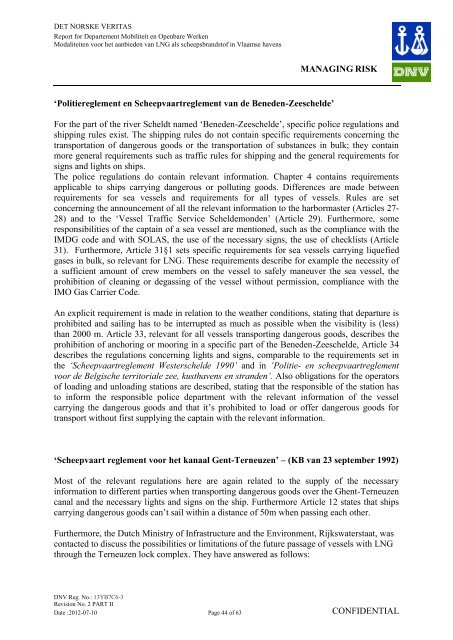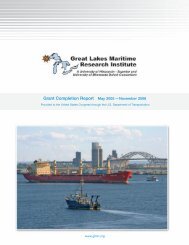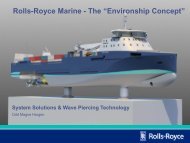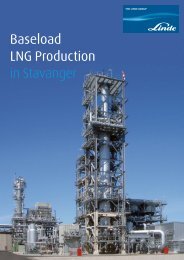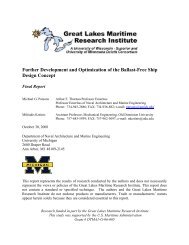Modalities for the provisioning of LNG as shipping fuel in Flemish Ports
Modalities for the provisioning of LNG as shipping fuel in Flemish Ports
Modalities for the provisioning of LNG as shipping fuel in Flemish Ports
You also want an ePaper? Increase the reach of your titles
YUMPU automatically turns print PDFs into web optimized ePapers that Google loves.
DET NORSKE VERITAS<br />
Report <strong>for</strong> Departement Mobiliteit en Openbare Werken<br />
Modaliteiten voor het aanbieden van <strong>LNG</strong> als scheepsbrandst<strong>of</strong> <strong>in</strong> Vlaamse havens<br />
MANAGING RISK<br />
‘Politiereglement en Scheepvaartreglement van de Beneden-Zeeschelde’<br />
For <strong>the</strong> part <strong>of</strong> <strong>the</strong> river Scheldt named ‘Beneden-Zeeschelde’, specific police regulations and<br />
<strong>shipp<strong>in</strong>g</strong> rules exist. The <strong>shipp<strong>in</strong>g</strong> rules do not conta<strong>in</strong> specific requirements concern<strong>in</strong>g <strong>the</strong><br />
transportation <strong>of</strong> dangerous goods or <strong>the</strong> transportation <strong>of</strong> substances <strong>in</strong> bulk; <strong>the</strong>y conta<strong>in</strong><br />
more general requirements such <strong>as</strong> traffic rules <strong>for</strong> <strong>shipp<strong>in</strong>g</strong> and <strong>the</strong> general requirements <strong>for</strong><br />
signs and lights on ships.<br />
The police regulations do conta<strong>in</strong> relevant <strong>in</strong><strong>for</strong>mation. Chapter 4 conta<strong>in</strong>s requirements<br />
applicable to ships carry<strong>in</strong>g dangerous or pollut<strong>in</strong>g goods. Differences are made between<br />
requirements <strong>for</strong> sea vessels and requirements <strong>for</strong> all types <strong>of</strong> vessels. Rules are set<br />
concern<strong>in</strong>g <strong>the</strong> announcement <strong>of</strong> all <strong>the</strong> relevant <strong>in</strong><strong>for</strong>mation to <strong>the</strong> harborm<strong>as</strong>ter (Articles 27-<br />
28) and to <strong>the</strong> ‘Vessel Traffic Service Scheldemonden’ (Article 29). Fur<strong>the</strong>rmore, some<br />
responsibilities <strong>of</strong> <strong>the</strong> capta<strong>in</strong> <strong>of</strong> a sea vessel are mentioned, such <strong>as</strong> <strong>the</strong> compliance with <strong>the</strong><br />
IMDG code and with SOLAS, <strong>the</strong> use <strong>of</strong> <strong>the</strong> necessary signs, <strong>the</strong> use <strong>of</strong> checklists (Article<br />
31). Fur<strong>the</strong>rmore, Article 31§1 sets specific requirements <strong>for</strong> sea vessels carry<strong>in</strong>g liquefied<br />
g<strong>as</strong>es <strong>in</strong> bulk, so relevant <strong>for</strong> <strong>LNG</strong>. These requirements describe <strong>for</strong> example <strong>the</strong> necessity <strong>of</strong><br />
a sufficient amount <strong>of</strong> crew members on <strong>the</strong> vessel to safely maneuver <strong>the</strong> sea vessel, <strong>the</strong><br />
prohibition <strong>of</strong> clean<strong>in</strong>g or deg<strong>as</strong>s<strong>in</strong>g <strong>of</strong> <strong>the</strong> vessel without permission, compliance with <strong>the</strong><br />
IMO G<strong>as</strong> Carrier Code.<br />
An explicit requirement is made <strong>in</strong> relation to <strong>the</strong> wea<strong>the</strong>r conditions, stat<strong>in</strong>g that departure is<br />
prohibited and sail<strong>in</strong>g h<strong>as</strong> to be <strong>in</strong>terrupted <strong>as</strong> much <strong>as</strong> possible when <strong>the</strong> visibility is (less)<br />
than 2000 m. Article 33, relevant <strong>for</strong> all vessels transport<strong>in</strong>g dangerous goods, describes <strong>the</strong><br />
prohibition <strong>of</strong> anchor<strong>in</strong>g or moor<strong>in</strong>g <strong>in</strong> a specific part <strong>of</strong> <strong>the</strong> Beneden-Zeeschelde, Article 34<br />
describes <strong>the</strong> regulations concern<strong>in</strong>g lights and signs, comparable to <strong>the</strong> requirements set <strong>in</strong><br />
<strong>the</strong> ‘Scheepvaartreglement Westerschelde 1990’ and <strong>in</strong> ‘Politie- en scheepvaartreglement<br />
voor de Belgische territoriale zee, kusthavens en stranden’. Also obligations <strong>for</strong> <strong>the</strong> operators<br />
<strong>of</strong> load<strong>in</strong>g and unload<strong>in</strong>g stations are described, stat<strong>in</strong>g that <strong>the</strong> responsible <strong>of</strong> <strong>the</strong> station h<strong>as</strong><br />
to <strong>in</strong><strong>for</strong>m <strong>the</strong> responsible police department with <strong>the</strong> relevant <strong>in</strong><strong>for</strong>mation <strong>of</strong> <strong>the</strong> vessel<br />
carry<strong>in</strong>g <strong>the</strong> dangerous goods and that it’s prohibited to load or <strong>of</strong>fer dangerous goods <strong>for</strong><br />
transport without first supply<strong>in</strong>g <strong>the</strong> capta<strong>in</strong> with <strong>the</strong> relevant <strong>in</strong><strong>for</strong>mation.<br />
‘Scheepvaart reglement voor het kanaal Gent-Terneuzen’ – (KB van 23 september 1992)<br />
Most <strong>of</strong> <strong>the</strong> relevant regulations here are aga<strong>in</strong> related to <strong>the</strong> supply <strong>of</strong> <strong>the</strong> necessary<br />
<strong>in</strong><strong>for</strong>mation to different parties when transport<strong>in</strong>g dangerous goods over <strong>the</strong> Ghent-Terneuzen<br />
canal and <strong>the</strong> necessary lights and signs on <strong>the</strong> ship. Fur<strong>the</strong>rmore Article 12 states that ships<br />
carry<strong>in</strong>g dangerous goods can’t sail with<strong>in</strong> a distance <strong>of</strong> 50m when p<strong>as</strong>s<strong>in</strong>g each o<strong>the</strong>r.<br />
Fur<strong>the</strong>rmore, <strong>the</strong> Dutch M<strong>in</strong>istry <strong>of</strong> Infr<strong>as</strong>tructure and <strong>the</strong> Environment, Rijkswaterstaat, w<strong>as</strong><br />
contacted to discuss <strong>the</strong> possibilities or limitations <strong>of</strong> <strong>the</strong> future p<strong>as</strong>sage <strong>of</strong> vessels with <strong>LNG</strong><br />
through <strong>the</strong> Terneuzen lock complex. They have answered <strong>as</strong> follows:<br />
DNV Reg. No.: 13YB7C6-3<br />
Revision No. 2 PART II<br />
Date :2012-07-10 Page 44 <strong>of</strong> 63 CONFIDENTIAL


